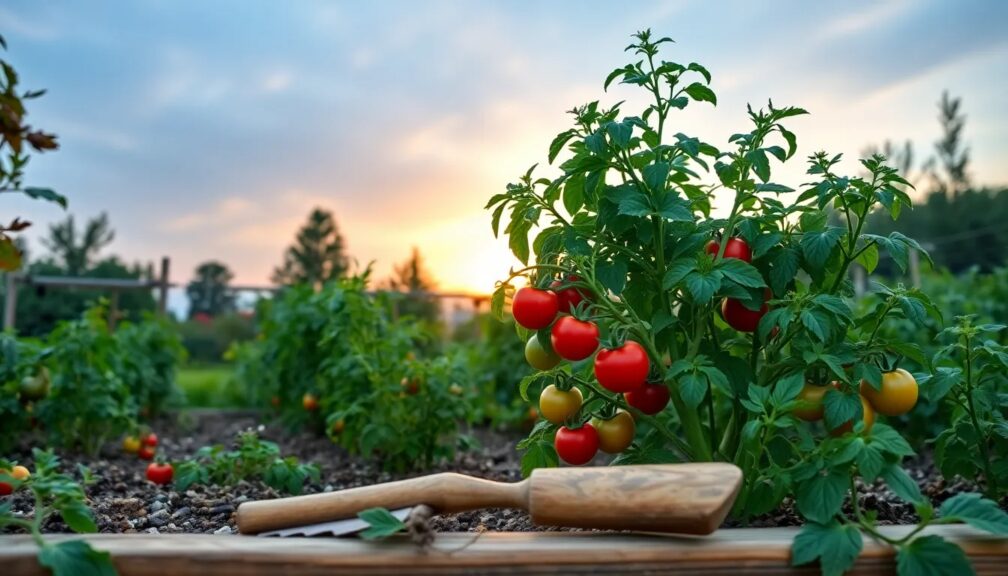Can you plant vegetables without tilling

Exploring No-Till Gardening: Growing Vegetables Without Disturbing the Soil
Gardening enthusiasts and sustainable agriculture advocates alike are turning towards no-till methods as a way to cultivate vegetables while preserving soil integrity and promoting environmental health. This approach to planting eschews the traditional practice of tilling, which involves turning over the soil before sowing seeds. Instead, no-till gardening focuses on layering organic matter, such as compost and mulch, directly on top of the soil to create a fertile planting bed. By understanding the principles and techniques of no-till gardening, you can reduce labor, conserve water, and build a robust, nutrient-dense soil ecosystem conducive to growing healthy, productive vegetables. In this article, we will delve into the benefits of this method, explore how to successfully start a no-till vegetable garden, and address common questions and challenges associated with this sustainable gardening practice.
Can I plant vegetables without tilling?
Imagine unlocking the secrets of a gardening technique that not only saves you back-breaking labor but also nurtures your soil's health and supports a thriving ecosystem right in your backyard. The answer to a lush, productive vegetable garden might just lie in a method that challenges conventional horticulture wisdom - one that requires no tilling whatsoever.
Yes, it's possible to cultivate a verdant oasis of vegetables without ever turning the soil. This approach, known as "no-till" or "no-dig" gardening, is gaining traction among green thumbs for its remarkable benefits. But how does it work, and what magic does it hold?
Discover the surprising advantages of no-till gardening:
- Enhanced soil structure: Tilling can disrupt the delicate web of life in your soil. By avoiding it, you maintain vital mycorrhizal networks that help plants absorb nutrients.
- Better water retention: Untouched soil retains moisture more effectively, reducing the need for frequent watering.
- Reduced erosion: Soil that isn't tilled is less prone to being washed or blown away, conserving your garden's precious topsoil.
But that's just scratching the surface. No-till gardening fosters a living soil ecosystem that can transform your gardening experience. It encourages the presence of worms and beneficial insects, which act as natural tillers and aerators, making your soil richer and more fertile over time.
Curious about how to start? It's simpler than you might think:
1. Begin with a layer of cardboard or newspaper to suppress weeds.
2. Pile on organic material like compost, leaves, or straw.
3. Plant directly into this layered bed and watch as your vegetables thrive with minimal interference.
The initial setup may sound easy, but the true magic happens over time. The layers break down, inviting a world of biodiversity that supports your plants. You'll find that your garden not only looks healthier but the produce is more vibrant and flavorful too.
And let's not forget the personal satisfaction you'll feel. No-till gardening is about embracing nature's rhythms. It's a step towards sustainable living and a way to reconnect with the earth. By choosing this path, you're not just growing vegetables; you're nurturing a slice of the environment and paving the way for a healthier planet.
Are you ready to revolutionize your garden? To embrace a technique that could save you time, bolster your garden's health, and mitigate your environmental impact? The journey to a no-till garden begins with a single step, and it's one you won't regret taking. Stay tuned to uncover the full array of no-till methods that will elevate your gardening game to the next level.
Can you plant a garden without a tiller?
Absolutely! Many gardeners are turning towards more sustainable, less disruptive methods to cultivate their own slice of Eden. Discover the joy of working with nature, rather than against it, with techniques that have stood the test of time.
Imagine your hands in the soil, the earthy aroma wafting through the air, and the gentle hum of life all around. This could be your reality with a no-till garden.
Firstly, let's address the intrigue that surrounds no-till gardening. It's a process that nurtures the soil biome, allowing earthworms and microorganisms to thrive. This natural activity leads to better soil structure and fertility, which in turn, promotes healthier plant growth.
But how exactly do you start? It's simpler than you might think.
1. Begin with layering organic materials – think of it as creating a lasagna right in your garden bed. Layers of compost, leaves, straw, and even newspaper can build a rich foundation for your plants without ever turning the soil.
2. Consider companion planting to boost your garden's harmony and productivity. By placing certain plants together, you can enhance growth, deter pests, and increase yield – all without the need for heavy machinery.
3. Use mulches to suppress weeds and retain moisture. Not only will this save you from painstaking weeding sessions, but it will also reduce the need for frequent watering.
The prospect of crafting a lush, vibrant garden without the roar of a tiller might seem too good to be true, but rest assured, it's a reality for many gardeners worldwide. And the benefits don't stop at environmental friendliness.
You'll also find that a no-till approach can mean less backbreaking labor and more time to simply enjoy your garden. Plus, by sidestepping the tiller, you're not just avoiding an extra rental fee or purchase cost – you're also creating a silent sanctuary, unmarred by the noise pollution of machinery.
If you're feeling the pull to dive into this peaceful, productive gardening practice, you're not alone. Embrace the anticipation of a thriving garden that resonates with the hum of life, rather than the rumble of engines. Your journey into no-till gardening could be the start of something groundbreaking – an oasis where nature and nurture coexist in perfect harmony.
Do you have to till before planting vegetables?
The question of whether tilling is a necessity before sowing the seeds for your next bumper crop has puzzled many gardeners. Imagine bypassing hours of strenuous work and still reaping the benefits of a lush vegetable garden. Preparing the soil is a crucial step, but the traditional method of tilling might not always be the royal road to a successful harvest.
Tilling has long been touted as a way to aerate the soil, eliminate weeds, and incorporate organic matter. However, the secret that many experienced growers won't tell you is that this time-honored practice could be eschewed for something better. Have you ever heard of no-till gardening? This innovative approach can enrich the soil structure, preserve moisture, and maintain the delicate ecosystem beneath our feet.
- It begins with understanding the soil's natural composition and the myriad organisms that call it home.
- From there, strategies such as mulching, composting, and cover crops come into play.
Diving into the world of no-till gardening might just be the game-changer your green thumb has been yearning for. Imagine the sense of accomplishment as you harvest vegetables that have thrived in a garden that is both productive and environmentally friendly. Don't miss out on the potential to revolutionize your gardening practices – the results might be too fruitful to ignore.
How do farmers plant without tilling?
Imagine stepping into a field where the soil is rich, the ecosystem is thriving, and the plants are flourishing, all without the traditional disruption of plowing and turning the earth. This is the incredible world of no-till farming, a method that's not just preserving the integrity of the soil, but also revolutionizing agriculture as we know it.
As you delve into the secrets of no-till agriculture, you'll uncover techniques such as direct seeding, where seeds are precisely sown into undisturbed soil. Farmers use specialized drills that penetrate the ground, depositing seeds in perfect alignment, all without the need for the exhaustive labor of traditional tilling.
But wait, there's more! This method is not just about planting seeds; it's a holistic approach to farming. Cover crops play a pivotal role, blanketing the earth and providing a living mulch that adds nutrients, prevents erosion, and maintains soil moisture. When the time comes, these cover crops are rolled down or crimped, creating a natural mat that suppresses weeds – yes, meaning less need for harmful herbicides.
You're probably wondering, "What about the hard, compact soil left by years of tilling?" Fear not, for in no-till farming, the soil structure is meticulously maintained. Over time, the activity of earthworms and other organisms creates a network of natural channels that allow roots to penetrate deep into the earth, enhancing drought resistance and reducing the need for water.
The beauty of no-till farming doesn't end there. It's a guardian of our environment, significantly reducing the carbon footprint of agriculture by keeping carbon safely stored in the soil. Plus, it's a method that's gaining traction worldwide, with farmers experiencing higher yields, lower costs, and ultimately, greater profits.
Are you feeling the pull to learn more about this agricultural marvel? No-till farming is not just a passing trend; it's a movement that's here to stay, transforming landscapes and offering a beacon of hope for a sustainable future in farming. Stay tuned as we delve deeper into the intricacies of this groundbreaking technique and reveal how it's changing the face of agriculture, one no-till field at a time.
How long can you plant vegetables without tilling
Have you ever wondered about the untapped potential of your garden, lying dormant just beneath the surface? The secret to unlocking a lush, productive vegetable oasis may reside in one simple, yet transformative practice: bypassing the tilling process altogether. The question that whispers through the green leaves isn't just about sustainability; it's about the longevity of a no-till garden.
Embarking on this journey, you might discover a ground-breaking approach that could redefine your gardening experience. Imagine cultivating a bustling ecosystem where plants thrive for not just one season, but year after year, without the need for disruptive soil turnover.
While the exact timeframe can hinge on diverse factors such as climate, soil type, and plant variety, the key to success lies in understanding and nurturing the soil's natural structure and fertility. By doing so, you can potentially sustain a no-till garden indefinitely. Here's a glimpse of what this method holds:
- Enhanced Soil Health: Each undisturbed layer teems with beneficial microbes and earthworms, forming a vibrant community that enriches the soil.
- Better Water Retention: As the soil structure improves, so does its ability to hold moisture, reducing the need for frequent watering.
- Reduced Labor: Say goodbye to the backbreaking work of traditional tilling and embrace a more streamlined approach to gardening.
- Natural Weed Suppression: A layer of mulch can serve as a barrier to weeds, saving you the hassle of constant weeding.
Don't let the fear of change keep you from experiencing the multitude of benefits a no-till garden offers. As the seasons cycle, you'll witness a transformation not just in your garden beds, but in your entire perspective on gardening and its impact on the natural world.
The truly revolutionary aspect of a no-till garden is that with each passing season, the benefits grow exponentially. The longer you maintain this practice, the more profound the results. From a flourishing biodiversity to a marked increase in yield, there's an ever-growing list of reasons to explore this path.
If your curiosity is piqued, and the sense of missing out is starting to take root, don't let this opportunity wither on the vine. Unlock the full potential of your garden without ever turning the soil again. Dive in to discover the lasting legacy that a no-till garden can leave on your land, your life, and the environment.
Consejo final: For those looking to plant vegetables without tilling, it's essential to focus on building healthy soil. Employ methods like mulching, composting, and using cover crops to enrich the soil and encourage beneficial organisms. Be patient as the soil ecosystem becomes more robust, making it easier for your vegetables to thrive without the need for tilling.
Best wishes on your gardening journey!
 Will a tiller break up hard soil
Will a tiller break up hard soil How do you till soil without a tiller
How do you till soil without a tiller Will a tiller work on hard soil
Will a tiller work on hard soil What is an alternative to tilling
What is an alternative to tilling Should you loosen roots before planting
Should you loosen roots before plantingIf you want to know more about similar articles like Can you plant vegetables without tilling you can visit category Gardening Tools.